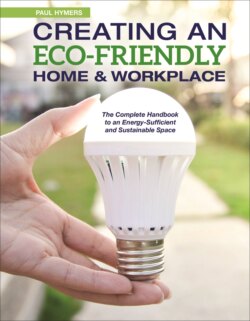Читать книгу Creating an Eco-Friendly Home & Workplace - Paul Hymers - Страница 19
На сайте Литреса книга снята с продажи.
Position
ОглавлениеFinding the right position for a light fitting might just be the hardest of the three. The lights in your home may not be in the best positions at present. Ceiling lights can be used for general lighting of a floor by placing them centrally, or as spotlights placed over a chair or sofa to pick out reading areas or work surfaces. Pendant tungsten filament lights (TFLs) of 100 watts being common on a lounge ceiling, this is a good place to start. A compact fluorescent lamp (CFL) replacement of 11 watts would have coped with the ambient lighting requirement in most lounges, providing the background (ambient) light source, but now light emitting diode (LED) pendant lights provide far more lumens per watt than CFLs ever could.
Not all of these lamps are pretty to look at, however, so you might consider fitting a shade beneath it to deflect the light up and across the ceiling. If you do, make sure it is highly reflective because you will lose brightness in the reflection. Swirl and decor bulb shapes are available if they will be visible.
In most cases, the right position for a light must ensure that the sharp glare from the lamp itself doesn’t hit us in the eyes. With spots and LEDs, if the lamps themselves can’t be seen, just the light from them, then that is good positioning. If you’ve ever had a glass table lamp, you’ll know what I mean. The glare of the bulb fills your retina, even when you aren’t looking at it. In the early 1980s, fluorescent strip lights with their stark illumination were often fitted in kitchens where strong lighting is needed. They do cast a shadowless, even light over everything when mounted to a ceiling, but the fitting might take the older-style tubes known as T12s; LED tubes are the energy-efficient replacements for these, and apart from being slightly thinner, they appear no different. They are, however, within a superior class in the energy-efficient category.
Reading lights are a form of task light, but it isn’t always easy to direct them. You might prefer the freedom of being able to move furniture like armchairs and study desks around, in which case you won’t want to fix a wall or ceiling light in any position. Portable plug-in lamps are the answer, but they may only use tungsten-halogen bulbs, so make sure they come with dimmer controls. I have a portable standard lamp that combines an uplighter and a smaller reading light on a flexible stalk, both of which are dimmable, but I’d be even happier if the reading light was an LED cluster.
